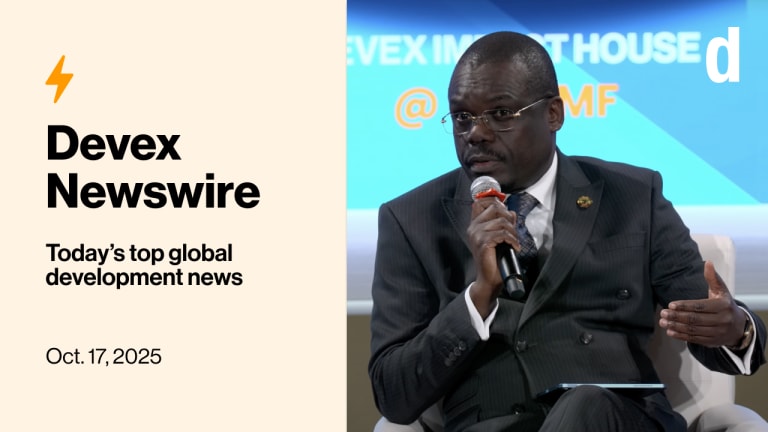
OKE ARO, Nigeria — At A & G Communication, a small mobile money transfer shop in Nigeria’s southwestern Ogun state, a small crowd congregates, waiting to either withdraw or send money. Obafemi Adebayo, a 65-year-old livestock farmer is there to make a direct deposit to his daughter’s account, who is studying at the Federal College of Education in Lagos, some 32 kilometers away from their home in semirural Matogun.
Adebayo is a member of the 60 percent of Nigerian adults without a bank account. According to the World Bank Global Findex Database report, Nigeria and six other countries are home to nearly half of the 1.7 billion people without bank accounts.
While Adebayo’s three children are educated and are constantly encouraging him to open an account, the possibility of banks losing his hard-earned money has kept him from doing so. “I followed my client to the ATM one time — he wanted to pay me for meat I delivered to him and the machine showed an error… He [then] got a text message saying he had withdrawn money, but we didn’t get the money,” Adebayo said to explain his mistrust.
For residents of Matogun, the closest banks are in Fagba — a suburb of Lagos 8 kms away. There are three ATMs there that are plagued with long lines and frequently out of service.
Before shops such as A & G Communication appeared, people like Adebayo performed basic banking services — savings and withdrawals — through cooperative societies sometimes known locally as Ajo and Esusu, or through microfinance banks.
More on financial inclusion:
► Insights from the World Bank's 2017 Global Findex database
But as the Nigerian government began pushing for a cashless policy to usher the country into a new era of digital banking mostly to combat fraud, “Paga shops,” as they are locally known in reference to the country’s biggest digital payments company now perform banking services. The popularity of these shops, which are essentially kiosks with point-of-sale machines and cash, has grown, especially given Nigeria’s shortage of banks.
Currently, there are 23 commercial banks spread across 5,000 bank branches in Nigeria. Most of these banks are clustered together as they are able to tap from the same network infrastructure and security.
In recent times, banks have created new partner programs to extend their reach to unbanked regions in Nigeria. Speaking to Quartz Africa, Tosanwumi Atiren, a process improvement officer at Nigerian bank Stanbic IBTC, explained that from a business point of view, the running costs for ATMs and bank branches are high and banks are constantly looking to innovate in cutting costs.
Banking models have evolved over time, and a new phase in this evolution is banks creating partner programs to extend services where brick and mortar banks do not exist.
For Adebayo, these new kiosks are all the bank he needs. “The majority of the people doing business here don’t use bank accounts. Our businesses are in cash and the banks are far. Here, we know the people we are giving money to,” he exlained.
While Adebayo is financially well-off compared to a lot of his neighbors, there is a recurring theme of poverty and petty trade that renders banks obsolete. Adebayo employs two people at his farm and they earn 12,000 Naira monthly ($33). With barely enough to live on, and no time to spend travelling to the usually overcrowded banks, Paga shops are the right model for his employees.
Beyond providing savings and deposits, these shops are also retail agents, especially for redeeming electricity, internet, and cable TV subscriptions. Their popularity, however, came from a lack of cash in Nigeria that created a need for cashback services — especially in semirural regions.
In addition to offering basic banking services, Paga shops also offer bank account opening services. But according to Omolade Ojobo, a Paga agent in Oke Aro, account opening has not really taken off.
“While we mostly help customers make withdrawals and deposits, we encourage people to open bank accounts, but a majority of people that open accounts don’t regularly operate them.”
In the past few years, numerous players have entered the “community banking” market. As well as the popular Paga shops, the non-bank player Kudi has grown in use. And very recently, banks such as First Bank and First City Monument Bank have joined the market, with FirstMonie and FCMB agents respectively.
But as Nigeria looks to move on from its tag as the “poverty capital” of the world and take a huge percentage of its people out of poverty, getting the population banked is a major first step.
“A large unbanked population stops an economy from growing as fast as they can while deepening inequality.” Michael Famoroti, chief economist at Vetiva Capital Management Limited, explains. “People are left without access to formal financial services like loans and insurance, essentially tools to help them grow their businesses and build their futures.”
Mobile money has been a vehicle for financial inclusion in sub-Saharan Africa with increases of 23 percent in 2011 to 43 percent in 2017. Yet in Nigeria, mobile money has not taken off to the heights it has reached in Kenya with M-Pesa, for example. The Democratic Republic of the Congo has fared better, experiencing an increase from 3.7 percent to 26 percent in the past decade.
Community banks are part of the future of banking, and while they may currently be imperfect solutions, they are moving to be better placed as members of a wider, banking industry.
Adebayo admitted he is considering opening a Paga account, especially as there are several agents near him. For people like him, these kiosks provide the trust and personalized service that bigger banks might not. At the microlevel, community banks are a step in the direction of financial inclusion.








